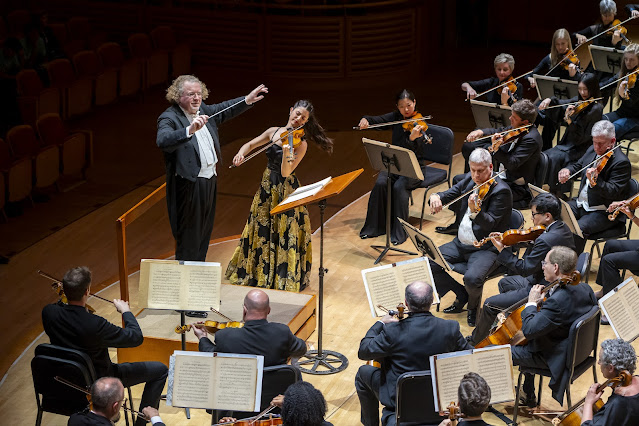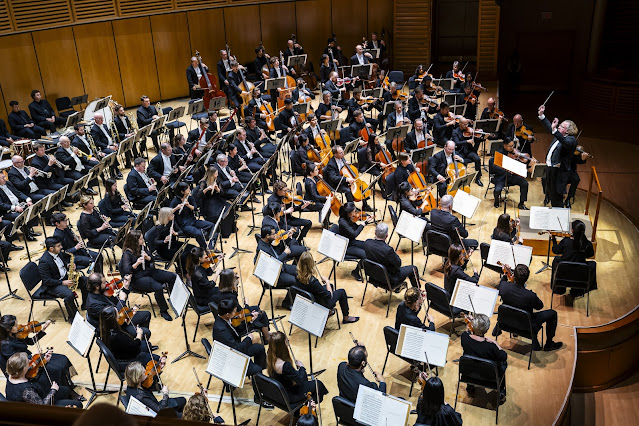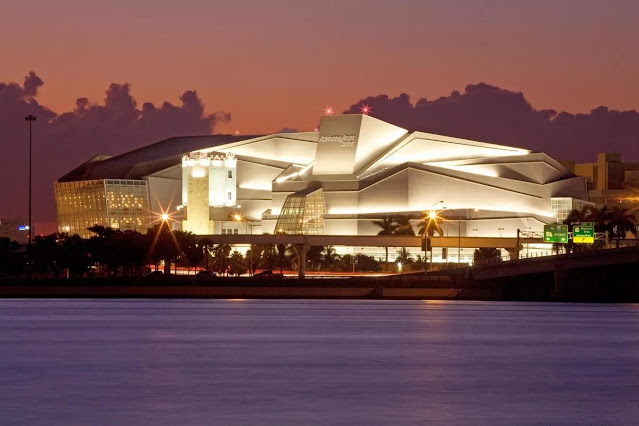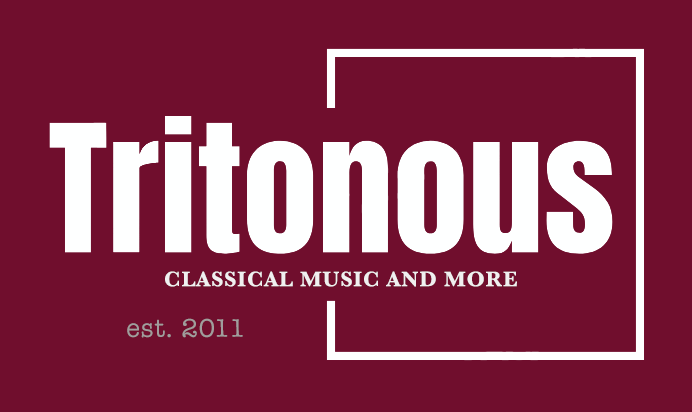 |
| Lalo: Symphonie Espagnole – Stephane Deneve, Maria Duenas, The Cleveland Orchestra – Arsht Center, Miami |
Dvorak: Symphony No.8, Bizet: Suite from L’Arlesienne (compiled by Stephane Deneve), Lalo: Symphonie Espagnole; Maria Duenas, Cleveland Orchestra, Stephane Deneve; Adrienne Arsht Center for the Performing Arts, Miami, Florida
Reviewed by Robert J Carreras (1 February 2025)
In our latest Letter from Florida, Robert J Carrera enjoys The Cleveland Orchestra as part of its Miami Residency in Dvorak and Bizet, and joined by Spanish violinist Maria Duenas in Lalo.
One violin. One contrabass. One oboe. One trombone. One harp…well, there is only one harp…I beg your indulgence. Is it possible for a full orchestra to play as one? No, not absolutely. Such a thing does not exist in nature. The possible is in the perfecting, not the perfection. It is hard to imagine any orchestra getting closer to playing as one, though, than The Cleveland Orchestra.
Sokoloff, Leinsdorf, Szell, Boulez, Maazel, Dohnányi – the storied list of past Cleveland Orchestra musical leaders and achievements parallel those of the modern history of classical music worldwide. Most recently, Franz Welser-Möst has been added to that list, the top job at Cleveland. Most has been entrusted to maintain and expand on the musical fruits of the orchestra’s heritage.
For this performance, however, at the helm of The Cleveland Orchestra is Stephane Deneve, himself entrusted to maintain and expand on the heritage of New World Symphony (NWS) based in Miami. NWS Co-Founder and Artistic Director Laureate Michael Tilson Thomas passed the baton to Deneve in 2022. In Deneve, both groups – and one baton – is in hands and mind with notably more nuanced notions, a wider scope, and a deliciously elegant musical approach, more perhaps than even the most celebrated of those on Cleveland’s list, and a longer one worldwide. [for the performance members of the New World Symphony Orchestra joined the Cleveland Orchestra in the Bizet and Dvorak].
 |
| Stephane Deneve, The Cleveland Orchestra – Arsht Center, Miami |
Deneve keeps time like a Swiss watch sipping French cafe, with Marseillaise sensibilities and savoir faire (he went scoreless for one thing). His relationship to band members shows beautifully in how they respond to him. He exudes warmth, with a smile and bonhomie that are infectious. This may be the je ne sais quoi that sets him apart from others. Deneve is a gentleman conductor.
Bizet’s “Carillon” from L’Arlesienne got the proceedings off to an auspicious start and set the tone for the concert – with flexibility and the merging of articulation in and between sections and by holding a melody’s dynamic shifts while sustaining a cogent and emergent phrase line. The “Adagietto” requires this and a whole other set of orchestral foci, with emphasis on strings taking different melodic directions. Deneve and players achieved nimble and seamless transitions in this delicate movement.
One of The Cleveland Orchestra’s strengths is how well they communicate inter-instrumentally. “Minuetto” – the third movement performed from L’Arlesienne this night, contains a series of call and responses between instrument sections that Deneve and company luxuriated in. The waves of the mid-part of this movement, with instrument sections weaving in and out of points of phrase and emphasis, were a brilliant coup of composure through circuitous course.
The solo flute player took the long lines and runs opening the “Menuet” with lungs from Olympus and solar plexus of steel; when the other players came in, The Cleveland Orchestra’s grandeur arrived and stayed true through the closing “Farandole.”
here is Stephane Deneve during all this? When his orchestra is performing wondrously, Deneve is apt to open the door and let them through to take center stage. He is a patient, deliberate conductor, highly selective about when to reveal the ringmaster. Nothing will perturb Deneve from his way – no type of tempi switch, musical design shift or soloist idiosyncrasy will do so.
The distinguished musical juggernaut that was Norman Lloyd once wrote, “The sounds that can be made by four fingers and a bow on four strings have not been exhausted.” It is on this score that violinist Maria Duenas figures prominently in classical music today.
Duenas warmed up in the “Scherzando” of Edouardo Lalo’s Symphonie Espagnole and did not look back. She didn’t need to – Deneve took care to step back on the podium to catch eyes with Duenas at crucial points of poetic polish. Deneve peeked at Duenas, then they shared a smile, signalling readiness for the synchronicity – sure fire and red-hot – that would be the “Intermezzo.”
Although Maria Duenas could have been channelling a gypsy soul from her very first entrance in Lalo’s Symphonie, it is at this point, in the third movement, when she poured it on – a remarkable display of the violin’s expressive range. Deneve and orchestra stayed with her at every musical turn. Duenas carries a light bow, getting good volume with dependable intonation, and the quality of her long-held notes and tremolo are the stuff of wonder. A native of Granada, Spain, Maria Duenas’ resting state suggests she knows she’s that good.
There was a dash of Spanish flavor in Dvorak’s 8th Symphony, freshly left over from Bizet and Lalo it would seem. In the same way passed on were the dramatic weight and precision-playing, in the undulating sweeps that support the arpeggiated flute’s songbird melody in the first movement. Deneve gets richer harmonics out of this piece than is usually heard live, the high violin digs and peaking winds sounding less strident. Knight Concert Hall’s acoustics may contribute to this.
No other composer understands the cello quite like Dvorak does, and Deneve clearly understands that. And yet still, cellos are integrated in a manner quite distinct here, deep-set like this through the dumka-like dance that is the “Allegretto.” This is more difficult to pull off in the fourth and final movement, where the trumpets open with a fanfare, and cellos recall subjects from earlier. The orchestra’s woodwinds issued a strongly defined reading of the score’s interesting chord modulations here.
Many musical notions and interpretive gifts come together and are somehow alchemized in the most integral of orchestral performances. Not quite one, but in process of perfecting. Stephane Deneve is one gentleman conductor that asked the flautist (Jessica Sindell) and harpist (Trina Struble), and the cellos to take a bow, and generously distributed des baisemain. One conductor. One violinist. One orchestra. Each one separate, and all together, worthy stewards of the heritage of classical music.
 |
| Adrienne Arsht Center, Miami (Photo: Tony Tur) |
The Cleveland Orchestra
Under the leadership of Music Director Franz Welser-Möst, The Cleveland Orchestra has cemented its place as one of the most sought-after performing ensembles in the world. The New York Times has declared it “the best in America,” “one of the finest ensembles in the country (if not the world),” and “America’s most understatedly amazing orchestra” for the group’s virtuosity, humility, self-confidence, elegance of sound, variety of color, and chamber-like musical cohesion.
Strong community support from across the ensemble’s home region is driving the Orchestra forward with renewed energy, increasing the number of young people attending concerts, and bringing fresh attention to the Orchestra’s legendary sound and committed programming — including programming that regularly juxtaposes older and newer musical works in standard concerts and festival settings, including annual opera presentations.
As The Cleveland Orchestra looks to the future, it strives to build community through music, removing barriers to participation, nurturing the next generation of musicians and audience members, and harnessing the life-changing power of music to make the world a better place. For more information, visit clevelandorchestra.com.
The Cleveland Orchestra Miami Residency
The Cleveland Orchestra’s Miami Residency was launched in partnership with the Adrienne Arsht Center in January 2007 during the Center’s inaugural season. Over the course of 17 seasons, The Cleveland Orchestra has served the Miami-Dade community with an array of musical presentations, including a series of subscription concerts, education programs, and community engagement activities. Since 2007, The Cleveland Orchestra has presented free daytime concerts and education programs to nearly 60,000 Miami-Dade County Public School District students — engaging with them through performances, coaching, mentorship opportunities, and special music programs.
The Cleveland Orchestra’s Miami concerts are presented in partnership with the Adrienne Arsht Center for the Performing Arts.
Adrienne Arsht Center for the Performing Arts of Miami-Dade County
Set in downtown Miami, the Adrienne Arsht Center for the Performing Arts of Miami-Dade County, which opened in 2006, is committed to welcoming and connecting ALL people to the arts, to the Arsht Center, with artists from around the world, innovative programming from our resident companies and local arts partners, free community events that reflect Miami’s unique identity, and arts education experiences for thousands of Miami children each year.
Each year, the Center serves more than 60,000 young learners and offers more than 100 culturally diverse and inclusive education programs — many enhanced by the Arsht Center’s relationship with schools, local teaching artists, and Miami-based arts organizations.
The Arsht Center is also a home stage for three resident companies —Florida Grand Opera, Miami City Ballet, and New World Symphony. The 300+ events each year include classical, jazz, Broadway, local theater, and much more, along with a robust series of touring Broadway musicals, a major annual Flamenco Festival, and an award-winning Miami-based theater program. In addition, Family Fest, Free Gospel Sundays, CommuniTEA LGBTQ+ celebration, and Heritage Fest are among dozens of free community events . For more information, visit arshtcenter.org.
The blog is free, but I’d be delighted if you were to show your appreciation by buying me a coffee.
Elsewhere on this blog
- A woman on the edge: Cherubini’s Médée in the original French version yet given a powerful modern twist with Joyce El-Khoury – opera review
- To create modern culture through the thoughts of the past: George Petrou artistic director of the Göttingen International Handel Festival introduces this year’s festival – interview
- Another crazy day: Joe Hill-Gibbins’ production of Mozart’s The Marriage of Figaro returns to ENO reinvigorated – opera review
- My Heart’s in the Highlands: the debut recital from tenor Glen Cunningham mixes Stuart MacRae’s new songs with other composers with ‘Scotland in Mind’ – record review
- Unbearable intensity: musically strong revival of Janáček’s Jenůfa at the Royal Opera with incoming music director Jakub Hrůša on searing form in the pit – opera review
- Schubert’s Birthday at Wigmore Hall: Konstantin Krimmel in overwhelming form, with a welcome group of Carl Loewe too – concert review
- Bruckner’s obsession with death, Scottish Gaelic folk poetry & a grumpy gaboon: Scottish composer Jay Capperauld, Scottish Chamber Orchestra’s associate composer – interview
- Letter from Florida: a study in contrasts, Gounod’s Roméo et Juliette at Palm Beach Opera – opera review
- 1775 – A Retrospective: Ian Page & The Mozartists on terrific form in a deep dive into the sound-world of Mozart’s 1775 – concert review
- Canadian composer Jacques Hétu’s final symphony in a new recording with three of Canada’s major ensembles – record review
- Home






